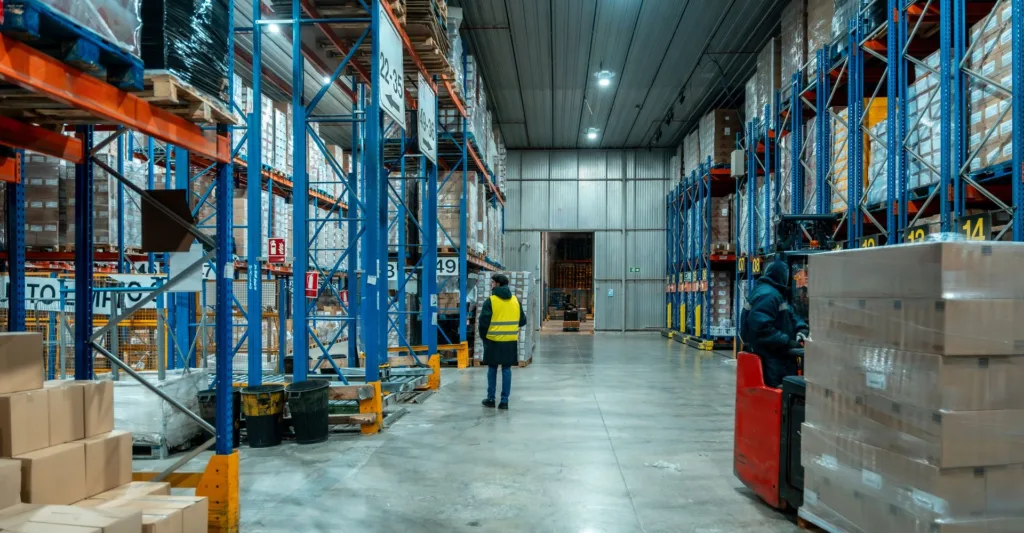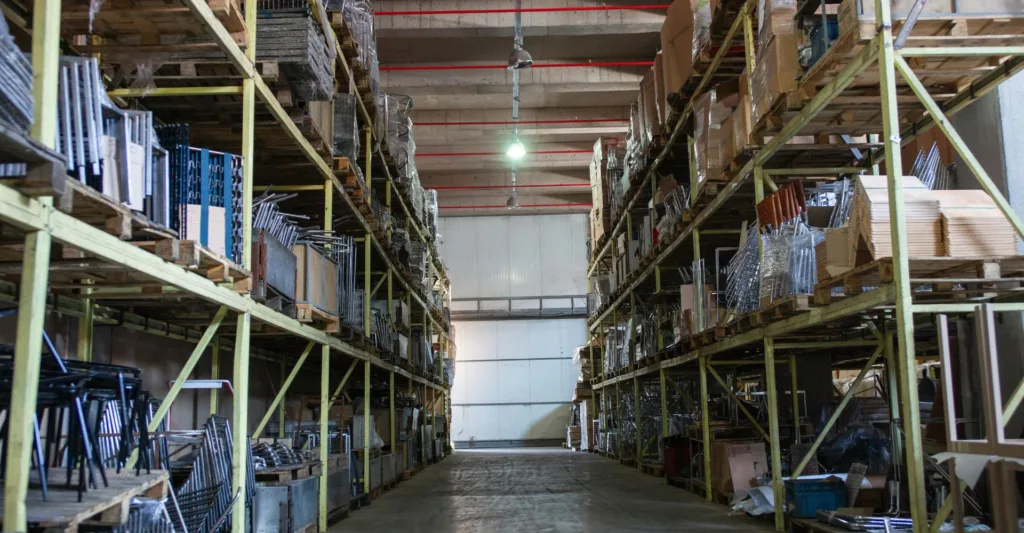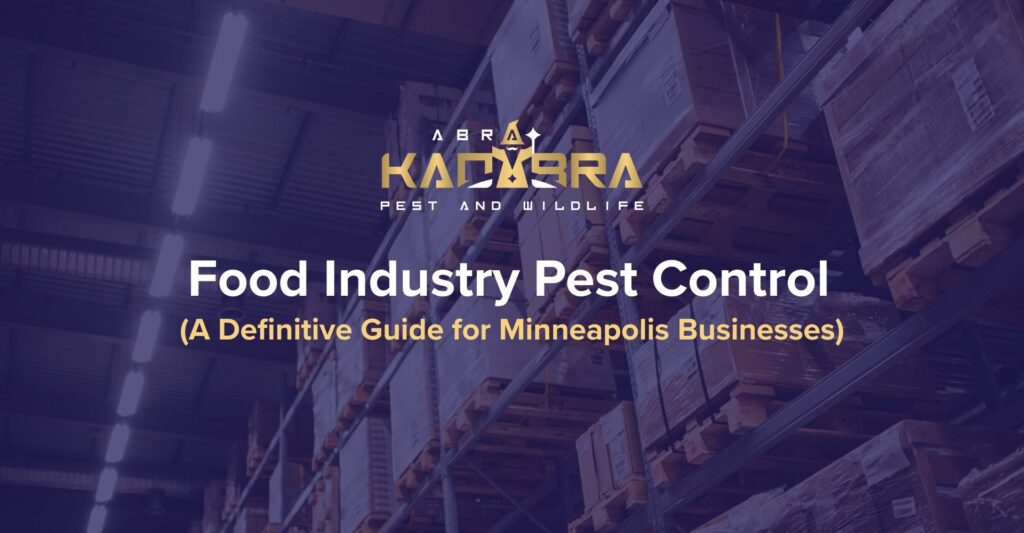Storage and distribution centers are the backbone of Minnesota’s food supply chain.
From cold-storage warehouses in the Minneapolis area to dry-goods distribution hubs across the Twin Cities, these facilities must protect product integrity, reputation, and public health.
A single pest sighting, Eg, a mouse in a palletized aisle, beetle fragments in a bag of flour, or bird droppings near an intake, can trigger product loss, regulatory action, and costly downtime.
This blog explains how food-storage operations in Minnesota can build a practical, defensible pest-control program that meets regulatory expectations and keeps operations moving smoothly.


The Importance of Pest Control in Food Storage
Pests contaminate products with hair, droppings, shed skins, and pathogens; damage packaging and infrastructure; and cause facility shutdowns and consumer recalls.
Regulatory frameworks and best-practice standards require proactive prevention, monitoring, and documentation, and not just reactive sprays.
For commercially licensed and inspected food operations in Minnesota, food-safety programs must include pest prevention and sanitation as core components.
Build a facility-specific Integrated Pest Management (IPM) plan
Integrated Pest Management (IPM) is the standard for food facilities because it emphasizes prevention, monitoring, and targeted control while minimizing chemical use. IPM for storage & distribution centers includes:
- Site assessment: Map entry points (docks, vents, door seals), food sources (spills, damaged packaging), harborage (pallet stacks, voids), and conducive conditions (standing water, accumulated debris).
- Sanitation protocols: Define daily, weekly, and monthly cleaning tasks — especially in receiving, staging, and high-traffic aisles. Clean spills immediately, remove excess cardboard and debris, and schedule deep cleans for racking and under pallet rows.
- Exclusion and building maintenance: Seal gaps, install proper door sweeps and strip curtains at dock doors, screen vents, and repair roof/soffit penetrations. Rodents and small insects exploit holes larger than a quarter-inch; make exclusion a maintenance priority.
- Monitoring: Place glue boards, pheromone traps, and bird netting where appropriate. Use a documented trap layout and check logs daily/weekly to make trends visible.
- Action thresholds: Define what counts as “normal” vs. “action required.” For example, one mouse sighting near product staging may trigger immediate exclusion and sanitation; multiple findings in traps may trigger trapping and facility-wide inspection.
- Targeted treatments: When treatment is necessary, use targeted baiting and spot treatments in non-food-touch zones, and follow label and regulatory limits. Avoid broadcast sprays where the product is exposed.
The EPA and USDA both stress IPM as the preferred, long-term approach for food storage and processing operations.
Pest risk factors in Minnesota warehouses
- Receiving and staging areas: Incoming materials and open pallets are common entry points for stored-product pests (e.g., pantry beetles, moths) and rodents. Inspect incoming shipments and reject infested pallets.
- Dock doors and loading bays: Large openings and frequent traffic make docks a top entry point for pests. Use dock seals, keep bay doors closed except during loading, and implement “clean dock” procedures.
- Pallet racking & high shelving: Food debris can fall into racking and go unnoticed for weeks. Periodic racking deep cleans are essential.
- Cold storage: Temperature control slows some pests but creates condensation and hard-to-clean condensate lines. Monitor humidity and inspect condensate drip areas.
- Exterior perimeters & landscaping: Overgrown vegetation, dumpsters, and improper exterior lighting attract rodents, birds, and insects. Manage landscaping and maintain 18–24 inches of cleared space around building foundations where possible.
- Waste management zones: Trash compaction and overflowing bins near doors create attractants. Use locked, covered dumpsters and regular removal schedules.


Minnesota-specific considerations
Minnesota’s seasonal swings affect pest pressure. Warmer months (late spring–early fall) bring stored-product insects and flies; as temperatures drop, rodents look for warm harborage and nest sites in buildings.
Facilities in the Twin Cities should adjust monitoring frequency seasonally. Property owners should increase trap checks and exterior inspections in autumn when rodents intensify indoor activity.
Also, state food-safety and public-health authorities expect pest prevention to be part of a facility’s documented food-safety plan. Ensure your IPM documentation aligns with local inspection requirements.
Sanitation checklist for warehousing operations
Use this as a living checklist that becomes part of daily SOPs:
Daily
- Sweep and spot-clean aisles; remove spilled product immediately.
- Keep dock areas free of debris and lock dumpster lids.
- Log and inspect installed monitors (glue boards, pheromone traps).
Weekly
- Empty and clean pallet positions that come into contact with the product.
- Inspect door seals, strip curtains, and exterior lighting.
- Check attic and ceiling gaps for bird or bat access.
Monthly
- Deep-clean racking (lift and clean under pallets).
- Review trap counts and look for trends; adjust placements.
- Service pest-exclusion hardware (screens, seals).
Quarterly
- Full facility IPM review with pest-management provider: sanitation gaps, structural repairs, and plan updates.
- Staff refresher training on spotting evidence and refusal protocol for suspect incoming loads.
Choosing the right professional pest-management partner
Large food facilities benefit from a pest-management partner experienced with food-industry requirements, third-party audits (BRC, SQF, GFSI schemes), and local inspections. A good provider will:
- Create a written IPM program with facility maps and trap layouts.
- Provide routine monitoring with digital logs and trend report capabilities.
- Train staff on evidence collection and incoming inspection protocols.
- Coordinate with operations to schedule treatments during low-traffic windows and ensure product safety.
If you’re in the Twin Cities and need a partner experienced in commercial food-industry environments, Abra Kadabra’s commercial pest control services explain how they approach businesses across the metro area and offer emergency response when problems arise.
Regulatory Paperworks to watch out for:
Regulatory and buyer audits expect documentation. Keep:
- Daily trap-check logs (date, trap ID, findings, action taken).
- Sanitation logs and corrective-action records.
- Incoming inspection reports and supplier rejection forms.
- Proof of technician certifications and pesticide label use (if applicable).
- Third-party audit records and corrective-action plans.
During an inspection, inspectors will look for organized, consistent evidence that pest management is active, predictable, and minimizes chemical exposure to food.
The FDA Food Code, state health rules, and USDA/industry guidance all underscored the importance of documented prevention and monitoring.
Pest Exposure Emergency SOP
No one wants to face a recall, but having a plan reduces damage. Your emergency SOP should include:
- Immediate containment: Isolate affected product, stop further distribution, and document lot numbers.
- Rapid assessment: Identify the pest, source, and scope using traps, forensic checks, and inspection of incoming pallets.
- Corrective actions: Deep-clean, seal entry points, and increase monitoring. Use only approved treatments and document everything.
- Communication plan: Know who in operations, quality, and leadership will notify buyers, auditors, and regulators if necessary.
- Post-event review: Root-cause analysis and permanent fixes to prevent repeat events.
Facilities participating in USDA programs or dealing with large retail buyers will be expected to demonstrate this kind of recall readiness.
How to Train Your Staff For Pest Prevention
The staff on the floor is your earliest warning system. Train them to:
- Recognize signs of infestation (droppings, gnaw marks, shed casings, live insects).
- Refuse or quarantine suspect incoming shipments.
- Record and report evidence promptly using the company’s digital or physical logs.
- Follow waste and pallet-stacking SOPs.
Regular, short toolbox talks (10–15 minutes) are more effective than infrequent long training sessions. Document attendance and topics covered.
Partner checklist: Notes for your pest-control provider
When you interview vendors, ask for:
- Written IPM program customized to your site.
- Digital reporting and trend analysis capabilities.
- Experience with food-industry audits and Minnesota regulatory inspections.
- Clear exclusion and sanitation recommendations, not just chemical treatments.
- Emergency-response availability and commercial emergency service clauses. (Abra Kadabra lists commercial emergency pest control services for the Twin Cities.)
Quick Tips
- Walk the receiving area and docks; seal obvious gaps and install a checklist for incoming shipments.
- Place or reposition trapping in known hot spots and create a daily check log.
- Empty and secure dumpsters and trash near dock doors.
- Schedule a quarterly racking deep-clean and add it to the maintenance calendar.
- Call a qualified commercial pest provider for a facility IPM assessment and written plan. (You can start with Abra Kadabra’s commercial pest control page to learn how they serve businesses across the Twin Cities.)
In Conclusion
Food storage and distribution centers operate on thin margins and tight schedules. Pests are not just an operational nuisance.
It is a reputational and regulatory risk. A carefully designed IPM program, rigorous sanitation routines, well-documented monitoring, and a strong partnership with a qualified commercial pest-control provider are your best insurance against product loss, recalls, and inspection failures.
If you’d like, I can convert this into a printable SOP checklist for your receiving dock, a trap-mapping template, or a sample vendor questionnaire for interviewing pest-management providers tailored to Twin Cities operations.
Sources:
- Abra Kadabra — Commercial pest control services (Twin Cities). Abra Kadabra
- FDA — Food Code and retail food protection guidance. U.S. Food and Drug Administration
- Minnesota Department of Health — Food safety and environmental health resources. Minnesota Department of Health
- EPA — Integrated Pest Management (IPM) principles. Environmental Protection Agency
- USDA / NAL — Research & guidance on pest management for stored products and grain.

